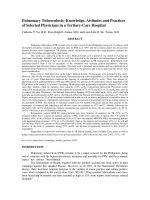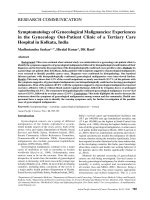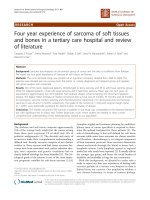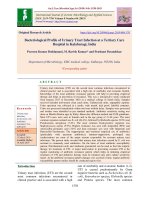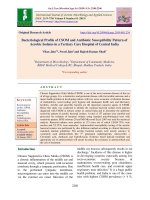Symptomatology of Gynecological Malignancies: Experiences in the Gynecology Out-Patient Clinic of a Tertiary Care Hospital in Kolkata, India pot
Bạn đang xem bản rút gọn của tài liệu. Xem và tải ngay bản đầy đủ của tài liệu tại đây (262.76 KB, 7 trang )
Asian Pacic Journal of Cancer Prevention, Vol 11, 2010
785
Symptomatology of Gynecological Malignancies in a Gynecology Out-Patient Clinic in Kolkata, India
Asian Pacic J Cancer Prev, 11, 785-791
Introduction
Gynecological cancers are a group of different
malignancies of the female reproductive system,
which include cancers of the ovary, cervix, body of the
uterus, vulva and vagina (Department of Health, Social
Services and Public Safety, Northern Ireland, 2002;
Senate Community Affairs References Committee,
Commonwealth of Australia, 2006). Gynecological
malignancies also include gestational trophoblastic
neoplasia (GTN) (Dutta, 2003).
Gynecological malignancies continue to be a major
cause of morbidity as well as mortality in women
worldwide (Siyal et al., 1999). Unfortunately, some
cancers seem to be on the increase. Over the years,
irrespective of social class, the number of gynecological
cancers is increasing, with more cases at the younger age
in India (Chhabra et al., 2002). In most of the developing
countries, including India, carcinoma of the cervix is
a major public health problem (Department of Health,
Social Services and Public Safety, Northern Ireland, 2002).
1
Department of Community Medicine,
3
Department of Obstetrics and Gynecology, Nilratan Sircar Medical College and Hospital,
Kolkata, India,
2
Department of Obstetrics and Gynecology, St. Francis Hospital and Medical Center, Hartford, USA,
4
Department
of Community Medicine, VM Medical College and Safdarjung Hospital, New Delhi, India * For correspondence : dr.madhutandra.
Abstract
Background: This cross-sectional observational study was undertaken in a gynecology out-patient clinic to
identify the symptoms suggestive of gynecological malignancies followed by histopathological conrmation of their
diagnoses and to determine the proportion of the histopathologically conrmed cases specic to sites. Methods: In
a gynecology out-patient clinic in Kolkata, India, patients with symptoms suggestive of gynecological malignancies
were screened to identify possible cancer cases. Diagnoses were conrmed by histopathology. One hundred
thirteen patients with histopathologically conrmed gynecological malignancies were interviewed further.
Results: This study shows that 5.3% of the overall outpatients or nearly one-fourth (23.7%) of the patients with
the symptoms suggestive of gynecological malignancies was histopathologically conrmed as having gynecological
malignancies. Most of the patients (87.0%) with the symptoms suggestive of gynecological malignancies reported
excessive, offensive with or without blood stained vaginal discharge, followed by irregular, heavy or prolonged
vaginal bleeding (61.4%). The commonest histopathologically conrmed gynecological malignancy was cervical
cancer (61.9%), followed by ovarian cancer (23.9%). Conclusions: This study highlights the need to increase the
awareness about the symptoms of gynecological malignancies among women and the community. Health care
personnel have a major role to identify the warning symptoms early for further investigation of the possible
cases of gynecological malignancies.
Keywords: Symptomatology - screening - gynecological malignancies - women
India’s cervical cancer age-standardized incidence rate
(30.7 per 100,000) and age-standardized mortality rate
(17.4 per 100,000) are the highest in South-Central Asia
(Ferlay et al., 2004). Having the highest fatality-to-case
ratio of all the gynecological malignancies, ovarian cancer
is of public health importance (Berek, 2002; Laurvick et
al., 2003). However, endometrial carcinoma and vulval /
vaginal carcinoma are usually the malignancy of elderly
women, thereby raising the mortality signicantly. It has
been reported in earlier literature by the same authors that,
in the developing countries like India, poor knowledge
about these cancers and health care seeking behavior of
the patients add to this burden signicantly (Sarkar et
al., 2010).
Methods for optimal screening of gynecological
cancers are still being investigated. Cervical cancer is
the only gynecological malignancy for which a screening
modality is widely accepted and recommended to
all women (Lea and Miller, 2001). However, being a
laboratory-based test, Pap smear requires appropriate
infrastructure and skilled manpower. This is a cost
RESEARCH COMMUNICATION
Symptomatology of Gynecological Malignancies: Experiences
in the Gynecology Out-Patient Clinic of a Tertiary Care
Hospital in Kolkata, India
Madhutandra Sarkar
1, 2*
, Hiralal Konar
3
, DK Raut
4
Madhutandra Sarkar et al
Asian Pacic Journal of Cancer Prevention, Vol 11, 2010
786
intensive procedure too. In Indian perspective, low-cost
options are more acceptable. Visual inspection tests are
being researched as low-cost alternatives to Pap smear.
In many cases, ovarian cancer is curable if detected early
(Senate Community Affairs References Committee,
Commonwealth of Australia, 2006). Though no modality
has been shown as an effective screening method for
ovarian cancer (Lea and Miller, 2001). Prevention of these
cancers also requires further improvement in the efciency
of the available screening methods.
Worldwide, cancer incidence rates vary widely
between different geographic regions and ethnic groups.
The estimation of cancer burden is valuable to set up
priorities for disease control (Sankaranarayanan and
Ferlay, 2006). In India, despite the network of registries
over the length and breadth of the country, a realistic
estimate of the gynecological cancers is lacking due to
the non-availability of adequate data, poor recording
systems, poor referral practices, lack of cancer awareness,
poor health education and inaccurate death certication.
Cancer registries in different parts of India reveal
that majority of cancer cases present in an advanced
stage (Directorate General of Health Services, Ministry
of Health and Family Welfare, Government of India,
2005), which reduces their chances of survival even after
treatment. Therefore, prevention, early detection and
treatment seeking pattern for cancer needs more attention.
The knowledge and skills in the above areas need to be
enhanced.
In order to understand the symptomatological
significance of identifying the possible cases of
gynecological malignancies, this study was undertaken
with the following objectives:
1) To identify the patients attending the gynecology
out-patient clinic suffering from the symptoms suggestive
of gynecological malignancies and histopathologically
conrm their diagnoses.
2) To nd out the proportion of the histopathologically
conrmed gynecological malignancies specic to its site.
Materials and Methods
This hospital-based cross-sectional observational
study was conducted in the gynecology out-patient clinic,
Department of Obstetrics and Gynecology, Nilratan Sircar
Medical College and Hospital, a tertiary care hospital in
Kolkata, West Bengal, India, over one year, from May
2006 to April 2007.
Study Population
The study population consisted of newly registered
patients with gynecological morbidity of variable severity,
attending the gynecology out-patient clinic of the above-
mentioned hospital.The number of days available for the
data collection was two xed days each week, which were
chosen by lottery method. Thus, Friday and Saturday
were chosen. According to the previous records (2002-
2003, 2003-2004 and 2004-2005), the total number of
gynecological malignancy patients reported annually on
Friday and Saturday was on an average 215, among the
average total number of 5,126 newly registered patients.
Therefore, the expected percentage of the patients
with gynecological malignancy, based on the previous
records, was calculated as 4.2%, among the total new
gynecological morbidity cases on Friday and Saturday.
As the expected number of patients with gynecological
morbidity during the period of study, based on the previous
records, was approximately 4,272, around 50% of these
patients, i.e. 2,136 were proposed to be selected for the
study, with random selection of the rst patient and then
every alternate patient. However, it was possible to cover
2,141 patients during the period of study.
Study Tools
1) A pre-designed and pre-tested checklist and a pre-
designed and pre-tested schedule; 2) Hospital records;
3) Past health records of the patients; 4) Investigation
reports, particularly histopathology reports; 5) Cusco’s
bivalve self-retaining vaginal speculum; 6) Stethoscope
and sphygmomanometer.
Methodology
Permission was obtained from the hospital authority.
The checklist and the schedule were drawn up in English,
translated in Bengali (local language) and back translated
in English to check the translation. Pre-testing of the
checklist and the schedule were done in the gynecology
out-patient clinic of the same hospital before starting
of the study on 10 patients and accordingly necessary
modications were made and these were nalized. The
gynecology out-patient clinic was visited as said. The
patients with the symptoms suggestive of gynecological
malignancies were screened out. Presence of at least two
suggestive symptoms was considered for inclusion of the
patients. The symptoms considered for screening were
contact bleeding, irregular, heavy or prolonged vaginal
bleeding, postmenopausal bleeding, excessive, offensive
with or without blood stained vaginal discharge, lump
in abdomen, abdominal distension or discomfort, vulval
growth. Informed consent was obtained to conduct the study
from all the eligible patients who were willing to cooperate
the physical examination and necessary investigations.
Necessary examinations and investigations, especially
histopathological examination were done for conrmation
of diagnosis. The checklist was used for screening and the
schedule was used for the patients with histopathologically
conrmed gynecological malignancies. The schedule
consisted of few sections, i.e. general information, detailed
history (menstrual history including menstrual hygiene,
obstetrical, medical, surgical, family and personal history),
presenting symptoms, clinical examination findings,
histopathological examination reports, denitive diagnosis
with FIGO staging of gynecological malignancies and
nally in-depth interview questions regarding knowledge
about gynecological malignancies and health care seeking
behavior of the patients.
Analysis of Data
Data obtained were collated and analyzed statistically
by simple proportions and tests of signicance (chi-square
test), as and when necessary.
Asian Pacic Journal of Cancer Prevention, Vol 11, 2010
787
Symptomatology of Gynecological Malignancies in a Gynecology Out-Patient Clinic in Kolkata, India
Limitations of the study
As the study population was screened out to identify
the possible cases of gynecological malignancies on the
basis of certain symptoms, few cases of gynecological
malignancies not having the suggestive symptoms might
have been missed.
This study was undertaken among women who
presented to a gynecology out-patient clinic for diagnosis
and treatment of gynecological morbidities and who
agreed to participate in the research. Care has to be
taken not to extrapolate the ndings of this study to all
women suffering from gynecological malignancies in the
community.
This study could possibly be compared with similar
studies from the developing world. The ndings of this
study might not corroborate with similar studies from the
developed nations.
Results
This study shows that, during the period of study,
the patients attending the gynecology out-patient clinic,
Department of Obstetrics and Gynecology of the said
hospital were screened out to identify the patients
suffering from the symptoms suggestive of gynecological
malignancies. Thus, 483 patients (22.6%) were screened
out among the 2,141 patients. After exclusion of 6
patients (0.3%) who were lost to follow up, 477 patients
(22.3%) suffering from the symptoms suggestive of
gynecological malignancies were further studied and the
diagnosis of all of them was conrmed by histopathology.
Finally, 113 patients, i.e. 5.3% of the overall outpatients
or nearly one-fourth (23.7%) of the patients with the
suggestive symptoms of gynecological malignancies were
diagnosed as the histopathologically conrmed cases of
gynecological malignancies.
Among the 2,141 patients screened, 1,658 (77.4%)
patients had absence of at least two suggestive symptoms
of gynecological malignancies. Maximum number of
patients (415 out of 2,141 patients or 19.4%) with at least
two suggestive symptoms reported excessive, offensive
with or without blood stained vaginal discharge, followed
by irregular, heavy or prolonged vaginal bleeding (13.7%)
and postmenopausal bleeding (4.7%). Other symptoms
reported were lump in abdomen (4.0%), abdominal
distension or discomfort (2.1%), contact bleeding (0.7%)
and vulval growth (0.1%) (Table 1).
Table 2 shows that most of the patients (415
out of 477 patients or 87.0%) with the symptoms
suggestive of gynecological malignancies presented
with excessive, offensive with or without blood stained
vaginal discharge, followed by irregular, heavy or
prolonged vaginal bleeding (61.4%) and postmenopausal
bleeding (21.2%). All the patients with contact bleeding
(14 patients) or vulval growth (2 patients) were suffering
from the histopathologically conrmed gynecological
malignancies. Higher proportion of the patients with
histopathologically conrmed gynecological malignancies
presented with postmenopausal bleeding (31.9%), lump in
abdomen (26.5%) and abdominal distension or discomfort
(22.1%) than that of the patients with other morbidities
(17.9%, 15.1% and 5.2% respectively).
Table 3 depicts that the commonest histopathologically
confirmed gynecological malignancy was cervical
Table 1. Distribution of the Study Population According
to the Suggestive Symptoms of Gynecological
Malignancies (n=2141)
Suggestive Symptoms* Number of Patients
Contact Bleeding@ 14 (0.7)
Irregular, Heavy or Prolonged Vaginal
Bleeding
293 (13.7)
Postmenopausal Bleeding 101 (4.7)
Excessive, Offensive With or Without
Blood Stained
Vaginal Discharge
415 (19.4)
Lump in Abdomen 85 (4.0)
Abdominal Distension or Discomfort 44 (2.1)
Vulval Growth 2 (0.1)
Absence of At Least Two Suggestive
Symptoms
1658 (77.4)
Figures in the parentheses indicate percentages.*Multiple
responses; @Contact bleeding: It includes bleeding during
examination and sexual intercourse; Source: Senate Community
Affairs References Committee, Commonwealth of Australia
(2006).
Table 2. Distribution of Patients with Histopathologically Conrmed Gynecological Malignancies and Other
Morbidities According to Suggestive Symptoms of Screening (n=477)
Suggestive Symptoms* Gynaecological
Malignancies
(n1 =113)
Other Morbidities#
(n2 =364)
Total
(n =477)
Contact Bleeding@ 14 (12.4) - 14 (2.9)
Irregular, Heavy or Prolonged Vaginal Bleeding 41 (36.3) 252 (69.2) 293 (61.4)
Postmenopausal Bleeding 36 (31.9) 65 (17.9) 101 (21.2)
Excessive, Offensive With or Without
Blood Stained Vaginal Discharge
78 (69.0) 337 (92.6) 415 (87.0)
Lump in Abdomen 30 (26.5) 55 (15.1) 85 (17.8)
Abdominal Distension or Discomfort 25 (22.1) 19 (5.2) 44 (9.2)
Vulval Growth 2 (1.8) - 2 (0.4)
Figures in the parentheses indicate percentages. *Multiple responses; @includes bleeding during examination and sexual intercourse;
#include dysfunctional uterine bleeding, broid uterus, adenomyosis, chronic pelvic infection, benign polyps, cervical ectopy, benign
ovarian neoplasms, cervico-vaginal infection, cervical tuberculosis, cervical intra-epithelial neoplasia
Madhutandra Sarkar et al
Asian Pacic Journal of Cancer Prevention, Vol 11, 2010
788
malignancy, which constituted 61.9% of the cases (70 out
of 113 patients), followed by ovarian malignancy (23.9%).
Only 6 patients (5.3%) were suffering from endometrial
malignancy. Gestational trophoblastic neoplasia was
found in 6 patients (5.3%). Vulval malignancy and vaginal
malignancy were rare (2 patients or 1.8% each).
More than two-third of the patients with gynecological
malignancies (78 out of 113 patients or 69.0%) were in
the age range of 35-64 years with mean age of 45.8 years.
More than two-third of the patients with gynecological
malignancies (69.0%) had come from rural area. Almost
all the patients with gynecological malignancies (96.5%)
were “ever-married”, i.e. currently married or widowed
or separated. More than half of the patients with
gynecological malignancies (54.9%) were illiterate / just
literate. Median value of the per capita monthly income
of family of the patients was Rs. 400 and mean value was
Rs. 543 with range of Rs. 100-2,500. The mean per capita
monthly income of family of the patients in this study is
nearly one-fourth of that of India’s value. Nearly two-third
of the patients with gynecological malignancies (64.6%)
were of parity 3 or higher with mean parity of 3.6.
Table 4 shows that the most frequently reported
symptom by the patients with gynecological malignancies
was excessive, offensive with or without blood stained
vaginal discharge (78 out of 113 patients or 69.0%),
followed by irregular, heavy or prolonged vaginal bleeding
(36.3%) and postmenopausal bleeding (31.9%). Other
symptoms reported were abdominal pain (29.2%), lump
in abdomen (26.5%), abdominal distension or discomfort
(22.1%), contact bleeding (12.4%), pruritus vulvae (3.5%)
and vulval growth (1.8%). Twenty-nine patients (25.7%)
reported miscellaneous symptoms including loss of
weight; respiratory distress; gastro-intestinal symptoms
like dyspepsia, loss of appetite with a sense of bloating
after meals, diarrhoea; urinary symptoms like frequency
of micturition, pain in urination, difculty in urination,
haematuria, true incontinence of urine. Out of these 29
patients who had miscellaneous symptoms, 17 patients
(58.6%) had ovarian cancer and 9 patients (31.0%) had
cervical cancer. Interestingly, miscellaneous symptoms
were present in 63.0% of the ovarian cancer patients and
12.9% of the cervical cancer patients.
This table also shows that most of the patients (65
out of 70 patients or 92.9%) with cervical malignancy
reported excessive, offensive with or without blood stained
vaginal discharge, whereas most of the patients (24 out of
27 patients or 88.9%) with ovarian malignancy reported
lump in abdomen and two-third of the patients (4 out of 6
patients or 66.7%) with endometrial malignancy reported
postmenopausal bleeding.
Discussion
This study is an attempt to understand the
symptomatological signicance of identifying the possible
cases of gynecological malignancies. In a previous study
by the same authors (Sarkar et al., 2010), it has been
reported that the knowledge about the disease and health
care seeking behavior of the patients suffering from
Table 3. Relative Frequencies of Gynecological
Malignancies (n=113)
Site of Malignancies Number (%)
Cervix 70 (61.9)
Ovary 27 (23.9)
Endometrium 6 (5.3)
Vulva 2 (1.8)
Vagina 2 (1.8)
GTN 6 (5.3)
Total 113 (100.0)
Table 4. Distribution of Patients with Gynecological Malignancies According to Presenting Symptoms (n=113)
Presenting
Symptoms*
Cervix
(n1 =70)
Ovary
(n2 =27)
Endometrium
(n3 =6)
Vulva
(n4 =2)
Vagina
(n5 =2)
GTN
(n6 =6)
Total
(n =113)
Contact
Bleeding@
12 (17.1) - 1 (16.7) - 1 (50.0) - 14 (12.4)
Irregular, Heavy or
Prolonged
Vaginal Bleeding
29 (41.4) 3 (11.1) 2 (33.3) - 1 (50.0) 6(100.0) 41 (36.3)
Postmenopausal
Bleeding
32 (45.7) - 4 (66.7) - - - 36 (31.9)
Excessive, Offensive With
or Without
Blood Stained
Vaginal Discharge
65 (92.9) 4 (14.8) 3 (50.0) 2(100.0) 2(100.0) 2 (33.3) 78 (69.0)
Lump in Abdomen 1 (1.4) 24 (88.9) 1 (16.7) - - 4 (66.7) 30 (26.5)
Abdominal Distension or
Discomfort
1 (1.4) 23 (85.2) 1 (16.7) - - - 25 (22.1)
Abdominal Pain 14 (20.0) 16 (59.3) 1 (16.7) - - 2 (33.3) 33 (29.2)
Vulval Growth - - - 2(100.0) - - 2 (1.8)
Pruritus Vulvae 1 (1.4) 1 (3.7) - 2(100.0) - - 4 (3.5)
Miscellaneous# 9 (12.9) 17 (63.0) - 2(100.0) - 1 (16.7) 29 (25.7)
Figures in the parentheses indicate percentages. *Multiple responses; @includes bleeding during examination and sexual intercourse;
#includes loss of weight, respiratory distress, gastro-intestinal symptoms like dyspepsia, loss of appetite with a sense of bloating after
meals, diarrhoea, urinary symptoms like increased frequency of micturition, pain in urination, difculty in urination, haematuria,
true incontinence of urine.
Asian Pacic Journal of Cancer Prevention, Vol 11, 2010
789
Symptomatology of Gynecological Malignancies in a Gynecology Out-Patient Clinic in Kolkata, India
gynecological malignancies is poor in India and it needs
immediate attention in order to reduce the burden of the
disease. Along with that, the health care personnel can
play a very important role to help reduce the burden. In
Indian scenario where regular medical check-up is not
a routine practice and huge population makes it almost
impossible to follow regular screening methods for all
women, awareness regarding the symptoms may be
helpful in prevention, early detection and timely treatment
of gynecological malignancies.
During the study period, among the 2,141 patients
attending the gynecology out-patient clinic of the said
hospital, 483 patients (22.6%) were identied as the
possible cases of gynecological malignancies on the basis
of their symptoms. After exclusion of 6 patients (0.3%)
who were lost to follow up, 477 patients (22.3%) could
further be studied and their diagnoses were conrmed
by histopathology. Finally, the diagnosis of 5.3% of
the overall outpatients (113 out of 2,141 patients) or
nearly one-fourth of the patients with the symptoms
suggestive of gynecological malignancies (23.7% or 113
out of 477 patients) was histopathologically conrmed
as gynecological malignancies. This indicates that
symptomatological screening may be a feasible option
for early detection of the possible cases of gynecological
malignancies.
Most of the patients (87.0%) with the symptoms
suggestive of gynecological malignancies reported
excessive, offensive with or without blood stained vaginal
discharge, followed by irregular, heavy or prolonged vaginal
bleeding (61.4%) and postmenopausal bleeding (21.2%).
All the patients with contact bleeding or vulval growth
were suffering from the histopathologically conrmed
gynecological malignancies. Higher proportion of the
patients with histopathologically conrmed gynecological
malignancies presented with postmenopausal bleeding
(31.9%), lump in abdomen (26.5%) and abdominal
distension or discomfort (22.1%) than that of the
patients with other morbidities (17.9%, 15.1% and
5.2% respectively). Among the 477 patients with the
symptoms suggestive of gynecological malignancies, the
patients were also having other morbidities diagnosed as
cervico-vaginal infection (29.0%), followed by chronic
pelvic infection (13.0%), dysfunctional uterine bleeding
(7.3%), broid uterus (6.9%), benign ovarian neoplasms
(6.1%), cervical ectopy (5.9%), benign polyps (5.0%),
adenomyosis (1.9%), cervical intra-epithelial neoplasia
or CIN (1.0%) and cervical tuberculosis (0.2%). So, it
can be said from the above ndings that the symptoms
like contact bleeding or vulval growth needs urgent
attention for management. Furthermore, any of the above-
mentioned symptoms should not be ignored and they need
careful attention to rule out malignancy. The patients with
the suggestive symptoms but not having malignancies
were diagnosed as having some other disease conditions
which also needed treatment. It has been reported in
earlier literature by the same author that abnormal vaginal
discharge is commonly present in the reproductive tract
infections (Dasgupta and Sarkar, 2008) and poor menstrual
hygiene is a very important risk factor for this ailment
(Dasgupta and Sarkar, 2008).
This study shows that cervical malignancy was the
commonest histopathologically conrmed gynecological
malignancy that constituted 61.9% of the cases, followed
by ovarian malignancy (23.9%). Contribution of other
malignancies was endometrial malignancy and gestational
trophoblastic neoplasia in 5.3% of the patients each.
However, vulval malignancy and vaginal malignancy
had the least contribution (1.8% of the patients each).
The nearly similar observations were found in a
hospital-based study conducted by Nkyekyer (2000) in
Ghana, which had reported that cervical cancer was the
commonest, constituting about 57.8% of gynecological
cancers, followed by ovarian cancer, endometrial cancer,
choriocarcinoma and vulval carcinoma (25.3%, 7.4%,
6.8% and 2.2% respectively). According to Mola and
McGoldrick (1982), the commonest gynecological
neoplasms registered in Papua New Guinea (PNG) were
cervical carcinoma (62%), followed by carcinoma of
the ovary (20.3%), carcinoma of corpus uteri (6.5%),
carcinoma of the vulva (5%), choriocarcinoma (4.7%)
and carcinoma of the vagina (1.2%). Chhabra et al.
(2002) observed in a study conducted in a rural institute
in India, that cervical cancer was the most common (80%)
of all gynecological malignancies, followed by ovarian
cancer (15%). Endometrial cancer was found only in
2.0% of all female genital malignancies. Gatphoh and
Darnal (1990) in an institution-based study reported that
ovarian carcinoma constituted 12.08% of all malignant
gynecological diseases and formed the second commonest
gynecological malignancy after carcinoma of the cervix
in Manipur, India. So, it is understood that, according to
published literatures, in the developing countries, cervical
malignancy is the commonest gynecological malignancy.
Further study should be carried out in the different regions
with different socio-economic backgrounds to conrm its
occurrence and presenting symptoms.
In the present study, the most frequently reported
symptom by the patients with histopathologically
conrmed gynecological malignancies was excessive,
offensive with or without blood stained vaginal discharge
(69.0%), followed by irregular, heavy or prolonged
vaginal bleeding (36.3%) and postmenopausal bleeding
(31.9%). Most of the patients (92.9%) with cervical
malignancy reported excessive, offensive with or
without blood stained vaginal discharge, whereas most
of the patients (88.9%) with ovarian malignancy reported
lump in abdomen and two-third of the patients (66.7%)
with endometrial malignancy reported postmenopausal
bleeding. Certain number of patients had miscellaneous
symptoms, which resembled very much after gastro-
intestinal, urinary and respiratory problems. Interestingly
enough, most of those patients (17 out of 29 patients
or 58.6%) had ovarian cancer. It is understood from
this observation that gynecological cancers especially
ovarian cancer may have non-specific or misleading
symptomatic presentation. Nearly similar to the ndings
of the present study, Chhabra et al. (2002) in a rural
institutional study in India observed that white / blood
stained discharge was complained by most of the patients
(61.2%) with gynecological malignancies, followed by
heavy, prolonged / infrequent menses / postmenopausal
Madhutandra Sarkar et al
Asian Pacic Journal of Cancer Prevention, Vol 11, 2010
790
References
Berek JS (2002). Novak’s Gynecology, Thirteenth Edition.
Philadelphia: Lippincott Williams & Wilkins.
Chhabra S, Sonak M, Prem V, et al (2002). Gynaecological
malignancies in a rural institute in India. J Obstet Gynaecol,
22, 426-9.
Dasgupta A, Sarkar M (2008). A study on reproductive tract
infections among married women in the reproductive age
group (15-45 years) in a slum of Kolkata. J Obstet Gynecol
India, 58, 518-22.
Dasgupta A, Sarkar M (2008). Menstrual hygiene: how hygienic
is the adolescent girl. Indian J Community Med, 33, 77-80.
Directorate General of Health Services, Ministry of Health
and Family Welfare, Government of India (2005). Manual
for Health Professionals. Manuals for Training in Cancer
Control. New Delhi: DGHS, MOHFW, GOI.
Dutta DC (2003). Text Book of Gynaecology including
contraception, Fourth Edition. Calcutta: New Central Book
Agency (P) Ltd.
Department of Health, Social Services & Public Safety, Northern
Ireland (2002). Epidemiology of Gynaecological Cancer
in Northern Ireland. Guidance for the Management of
Gynaecological Cancer, Belfast: DHSSPS.
Ferlay J, Bray F, Pisani P, et al (2004). GLOBOCAN 2002:
Cancer Incidence, Mortality and Prevalence Worldwide.
IARC Cancer Base, 5, Lyon: IARC Press.
Gatphoh ED, Darnal HK (1990). Pattern of ovarian neoplasms
in Manipur. J Indian Med Assoc, 88, 338-9.
Laurvick CL, Semmens JB, Holman CD, et al (2003). Ovarian
cancer in Western Australia (1982-98): incidence, mortality
and survival. Aust N Z J Public Hlth, 27, 588-95.
Lea JS, Miller DS (2001). Optimum screening interventions for
gynecologic malignancies. Tex Med, 97, 49-55.
Mola G, McGoldrick I (1982). Epidemiology of gynaecological
and female breast neoplasms in Papua New Guinea. P N G
Med J, 25, 143-50.
Nkyekyer K (2000). Pattern of gynaecological cancers in Ghana.
East Afr Med J, 77, 534-8.
Odukogbe AA, Adebamowo CA, Ola B, et al (2004). Ovarian
cancer in Ibadan: characteristics and management. J Obstet
Gynaecol, 24, 294-7.
Sarkar M, Konar H, Raut DK (2010). Knowledge and health care
seeking behavior in relation to gynecological malignancies
in India: a study of the patients with gynecological
malignancies in a tertiary care hospital of Kolkata. J Cancer
Education (in press).
Sankaranarayanan R, Ferlay J (2006). Worldwide burden of
gynaecological cancer: The size of the problem. Best Pract
Res Clin Obstet Gynaecol, 20, 207-25.
Senate Community Affairs References Committee,
Commonwealth of Australia (2006). Inquiry into
gynaecological cancers in Australia. Breaking the silence:
a national voice for gynaecological cancers. Canberra.
bleeding (57.1%). Most frequently reported symptom
among cervical malignancy patients was white / blood
stained discharge (76.9%). In contrary to the present
study, the most common presenting symptom among
ovarian cancer patients as found by Chhabra et al. (2002)
was pain in abdomen (62.8%). According to Odukogbe
et al. (2004), abdominal swelling was the most common
presenting symptom among the patients of ovarian cancer
in a hospital of Nigeria. Sultana and Kiyani (2005) in their
study conducted in a hospital of Pakistan observed that
bleeding per vagina was the commonest feature amongst
the patients of endometrial carcinoma. From the above
discussion, it is found that various possible symptoms
may likely be present in case of ovarian cancer, whereas
abnormal vaginal discharge might be the commonest
presenting symptom of cervical cancer.
This study reflects the importance of awareness
among women as well as the health care personnel about
the possible symptoms of gynecological malignancies
and highlights the need for addressing and prioritizing
resources towards educating women and the broader
community about these malignancies, especially the
symptoms.
It can be concluded from this study that the patients
can be identified as possible cases of gynecological
malignancies according to some suggestive symptoms,
especially when regular screening procedures cannot
be implemented in practice. So, women should be made
aware not only about the possible warning symptoms, but
also the urgency of seeking appropriate health care on
experiencing any symptom like excessive, offensive with
or without blood stained vaginal discharge, or irregular,
heavy or prolonged vaginal bleeding, or postmenopausal
bleeding, or contact bleeding, etc., because earlier a cancer
is detected, the easier it is to treat. Health care personnel
have a major role regarding this. Further, women should
also be assured that having these symptoms does not
mean that she have or will get cancer, but it indicates
that she should report to a qualied health care provider
promptly to exclude the possibility of malignancy as
early as possible. As found in the present study that these
symptoms might be present in other morbidities, which
also need treatment.
Cervical malignancy has been identified as the
commonest form of gynecological malignancy in this
study and this nding corroborates with the ndings of
the studies from other developing countries.
This study and reported literature indicate that cervical
malignancy has got some specic symptoms in most of
the cases. In contrary to that, symptomatic presentation of
ovarian cancer may be variable or non-specic in a good
percentage of the patients. So, health care personnel should
maintain a high index of suspicion while diagnosing
possible malignancy cases.
A thorough symptomatological screening for
gynecological cancer should be done in all women
coming for some problem in the hospital so as to detect
and treat the malignancies at the earliest and to decrease
the incidence of advanced cancer. Even if cancer is not
evident, continuation of follow up checking on a regular
basis need to be ensured.
Further research to identify more specic and feasible
options for early detection of gynecological malignancies
is urgently needed.
Acknowledgements
The authors are grateful to Profs. R Biswas and A
Dasgupta, Department of Preventive and Social Medicine,
All India Institute of Hygiene and Public Health, Kolkata,
India for their support and valuable suggestions.
Asian Pacic Journal of Cancer Prevention, Vol 11, 2010
791
Symptomatology of Gynecological Malignancies in a Gynecology Out-Patient Clinic in Kolkata, India
Siyal AR, Shaikh SM, Balouch R, et al (1999). Gynaecological
cancer: histopathological experiences at Chandka Medical
College and Hospital Larkana. Med Channel, 5, 15-9.
Sultana N, Kiyani N (2005). Histopathological features of
endometrial carcinoma. J Coll Physicians Surg Pak, 15,
539-42.
